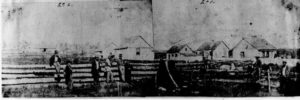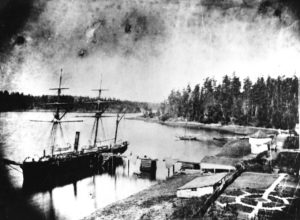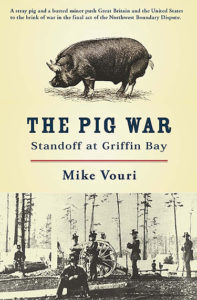San Juan Island National Historical Park is, of course, the reason Tom and I are on San Juan Island. The National Park owns 2,500 acres which makes it the biggest landowner on San Juan Island. The park has a very interesting story to tell about the making of the United States. Have you ever heard of the Pig War?
Back in 1818, the United States and Great Britain signed a treaty. The treaty set the boundary between the two countries in North America as the 49th parallel from Lake Superior to the Rocky Mountains. The area west of the Rocky Mountains was a wilderness considered to be of interest only to fur traders. As United States settlers continued to push west they soon outnumbered the British fur traders. In 1846 the Oregon Treaty was signed between the two countries. The 49th parallel continued to be the boundary, except for Vancouver Island, which was given to the British.
 A small group of islands between Vancouver Island and the mainland, but south of the 49th parallel went unnoticed by the politicians. The treaty stated that the land north of the Strait of Juan de Fuca and west of the main channel went to the British. Unfortunately there were two main channels: the Haro Strait and the Rosario Strait. The British considered the islands west of the Rosario Strait to be an extension of Vancouver Island. The Americans considered the islands east of the Haro Strait to be part of the United States.
A small group of islands between Vancouver Island and the mainland, but south of the 49th parallel went unnoticed by the politicians. The treaty stated that the land north of the Strait of Juan de Fuca and west of the main channel went to the British. Unfortunately there were two main channels: the Haro Strait and the Rosario Strait. The British considered the islands west of the Rosario Strait to be an extension of Vancouver Island. The Americans considered the islands east of the Haro Strait to be part of the United States.
The British governor of Vancouver Island, feeling that possession of the islands would decide the issue, put the first settlers on San Juan Island by establishing Belle Vue Sheep Farm. Within a few years, American settlers arrived “squatting” (according to the British) on British land. Washington Territory tried to levy taxes on the sheep farm. British officials tried to enforce British law on the Americans.

The dispute came to a head on June 15, 1959, when Lyman Cutlar – an American settler – shot a pig belonging to Belle Vue Sheep Farm. This was the start of the Pig War. When Lyman Cutlar refused to pay restitution, the governor of Vancouver Island ordered him arrested. Lyman Cutlar refused to go with the British authorities and they backed down.
The American settlers, fearing the next British officials would be less accommodating, asked for American troops to be sent to the island. Sixty-six American soldiers, under the command of Captain George Pickett, landed on the island. Vancouver Island Governor James Douglas ordered the British warship Tribune to San Juan Island. The situation escalated and by August 10, 1859, 461 Americans with 14 cannon were opposed by five British warships mounting 70 guns and carrying 2,140 men. With little provocation, the Pig War could turn deadly for more than just the pig!

Alarmed by the possibility of another war between the two countries, General Winfield Scott arrived to negotiate between the two sides. Both sides agreed to camps of soldiers of equal size on the island. The British Marines settled in English Camp on the northwest side of the island and kept law and order with the British settlers. The American Army soldiers settled on the southeast side of the island and kept order with the American settlers.
After 12 years of joint occupation, the boundary dispute was finally settled by international arbitration. Kaiser Wilhelm I of Germany gave the land to the Americans and set the boundary of the United States as the Haro Strait.
 For a humorous (but true) comic of the Pig War, check out this link. If you are interested in reading more, the San Juan Island National Historical Park historian, Mike Vouri, wrote this excellent book.
For a humorous (but true) comic of the Pig War, check out this link. If you are interested in reading more, the San Juan Island National Historical Park historian, Mike Vouri, wrote this excellent book.
Today American Camp and English Camp are part of the San Juan National Historical Park. We celebrate the good relationship between Vancouver Island and the San Juan Islands. And we are thankful that no soldiers or settlers were killed in the Pig War – a dispute with a great name and only one death (the pig).
